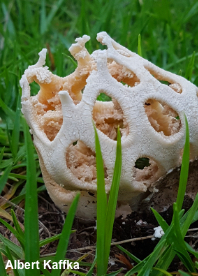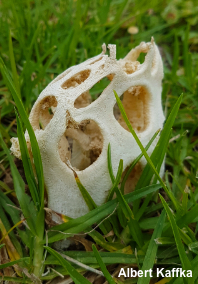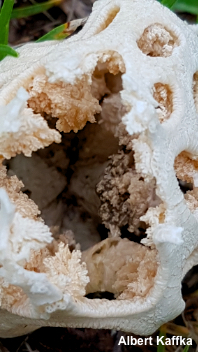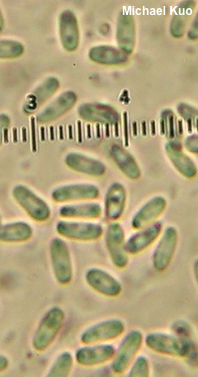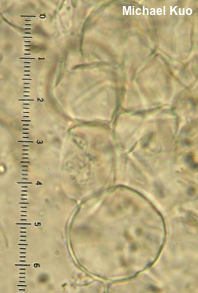| Major Groups > Stinkhorns > Clathrus baumii |

|
Clathrus baumii [ Basidiomycota > Agaricomycetes > Phallales > Clathraceae > Clathrus . . . ] by Michael Kuo Illustrated and described here is an interesting white stinkhorn from South Africa. It matches Clathrus baumii in the sense of mycologist D. M. Dring (1980), but it is a little uncertain whether Dring's concept corresponds perfectly with Clathrus baumii as it was originally described. The crucial identifying features for this mushroom are: the pale colors, the flattened arms that make up the cage structure, and the fact that the spore slime is produced on fairly large wart-like swellings ("glebifers," in Mycologese) at the intersections of the arms. According to Dring, the species "varies from white to pale ochraceous" and "should be easily recognizable by the strikingly flat outer surface of the arms." Clathrus baumii was originally described from Angola (Hennings, 1903) as a "flavo-aurantio" (Latin for yellow-orange) mushroom, without any mention of flattened arms—seemingly at odds with Dring's concept, although Hennings did emphasize the glebifers: "in axillis verrucam ferentibus pulpa sporarum atro-olivacea tegentem" (more or less: warts in the joints bearing blackish olive spore slime). The species was redescribed in 1963 from South Africa by Dissing and Lange, as "jaune vif à jaune brun" (bright yellow to yellowish brown) and without any mention of flattened arms—but, again, with special attention to the glebifers. In 1980 Dring reiterated Dissing and Lange's description of the species, and cited additional African drawings and collections of Clathrus baumii from Kenya, Tanzania, Uganda, and Zaire. However, Dring also placed the species in the Caribbean and South America, based on collections from R. W. G. Dennis, which Dring said differed from African material only in having "a pinkish volva." Complicating things even more, Dring based his illustrations (line drawings) of the species on the Caribbean and South American material, rather than the African material. Are you done yet? Because things get more complicated. The South American and Caribbean version with the pink volva has since been described as distinct from Clathrus baumii, as Clathrus roseovolvatus, by Lécuru and collaborators (2013). The description and photos portray a white species with arms that are not particularly flattened—and no glebifers; the spore slime of Clathrus roseovolvatus is produced all along the inner surfaces of the arms, without specialized, wart-like structures. Frustratingly, Lécuru and collaborators go to great lengths to compare their species with descriptions of Clathrus baumii, but appear not to have read the previous descriptions very carefully, because they make no note of the glebifer/no-glebifer difference—and in their key to "white or yellowish species of Clathrus" worldwide, they place only one glebifer-bearing species in Africa, Clathrus transvaalensis. The latter species is known from South Africa and features glebifers and pink to pinkish arms. Whew! So, unless I am missing something, the possibilities include: 1) the mushroom illustrated and described here is Clathrus baumii, which is found across Africa and ranges in color from yellow to white; 2) the mushroom is an undescribed species, mistaken for Clathrus baumii by Dring; 3) the mushroom is a pale, flat-armed version of Clathrus transvaalensis (in which case the possibility that Clathrus transvaalensis is really just a pink version of Clahtrus baumii arises). Thanks to Albert Kaffka for documenting, collecting, and preserving this species for study; his collection is deposited in The Herbarium of Michael Kuo. Description: Ecology: Saprobic; growing alone or gregariously in grassy areas; January; possibly widespread across Africa (see discussion above). The illustrated and described collection is from South Africa. Mature Fruiting Body: 8 cm high; 7 cm wide; consisting of a round-ish, hollow lattice that arises from a stemlike structure. Lattice Arms: About 1 cm wide and 3 mm thick; forming about 20 more or less round holes; edges of holes tightly striate for 2–4 mm; outer surfaces white, flattened, minutely pitted and spongelike; hollow; inner surfaces bumpy and dull yellowish; glebifers found on the inner surfaces at the intersections of the arms, 0.5–1.5 cm across, wart-like, bumpy. Pseudostem: Poorly defined; about 2 cm high, whitish to dull yellowish, enclosed in a whitish volva. Volva: Sac-like, encasing the base of the fruiting body; whitish. Spore Slime: Dark brown; covering the glebifers; very malodorous. Microscopic Features: Spores 3.5–5 x 1.5–2 µm; subcylindric; smooth; hyaline in KOH, often with two small guttules. Sphaerocysts of the pseudostipe 12–24 µm; subglobose; walls about 0.5 µm thick; hyaline in KOH. Hyphae of the volva 1–3 µm wide; smooth; thin-walled; hyaline in KOH; septate; clamp connections not found. REFERENCES: Hennings, 1903. (Dring & Rayner, 1967; Dring, 1980; Coetzee, 2010; Lécuru et al., 2013.) Herb. Kuo 01071701. This site contains no information about the edibility or toxicity of mushrooms. |
© MushroomExpert.Com |
|
Cite this page as: Kuo, M. (2020, September). Clathrus baumii. Retrieved from the MushroomExpert.Com Web site: http://www.mushroomexpert.com/clathrus_baumii.html |
